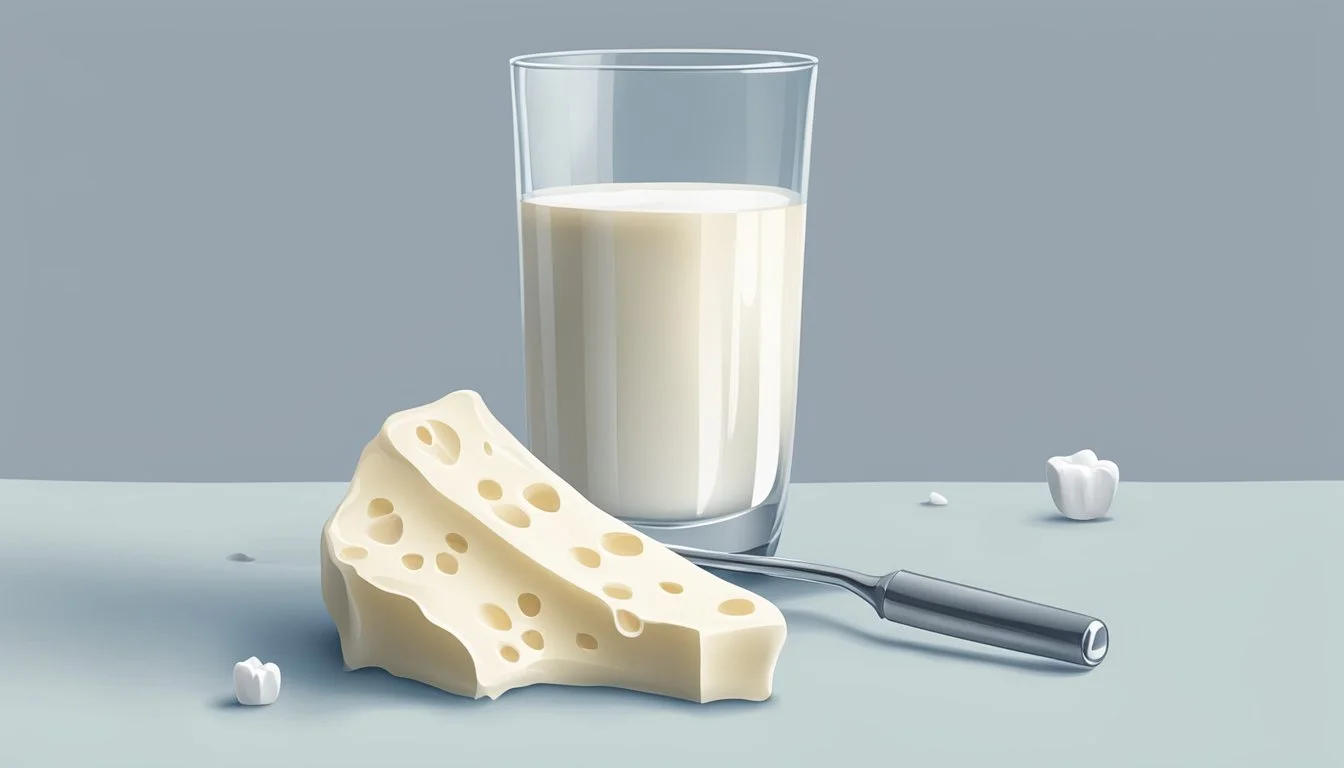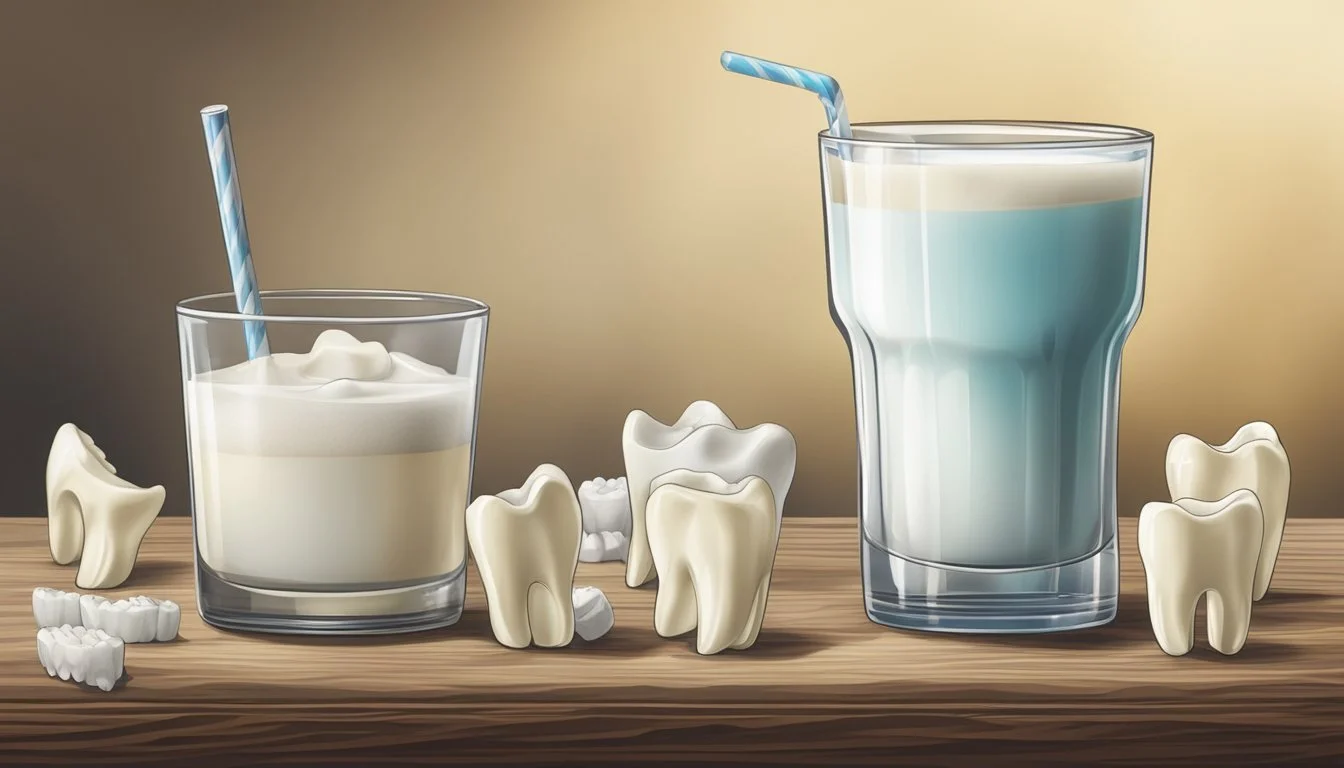Can Lactose Intolerance Cause Tooth Decay?
Understanding the Link
Lactose intolerance occurs when the body is unable to fully digest lactose, the sugar present in milk and dairy products, due to a deficiency of the enzyme lactase. This condition often results in gastrointestinal discomfort, such as gas, bloating, and diarrhea, after consuming dairy. While these symptoms are widely known, the potential impact of lactose intolerance on oral health is a topic of increasing interest. Individuals with lactose intolerance tend to avoid dairy, which is a primary dietary source of calcium - a mineral that is critical for maintaining strong teeth and bones.
The lack of sufficient calcium intake in lactose-intolerant individuals can pose a risk for oral health, particularly in the development of tooth decay. Calcium’s role in fortifying tooth enamel makes it essential in the prevention of cavities. When the diet is deficient in calcium, the body may withdraw this mineral from the teeth and bones, weakening their structure and possibly leading to oral health complications over time. Furthermore, research suggests that there may be a correlation between lactose intolerance and other conditions like celiac disease, which also have implications for dental health.
Understanding Lactose Intolerance
Lactose intolerance affects the ability to digest lactose due to insufficient levels of lactase enzyme, leading to symptoms ranging from discomfort to gastrointestinal distress. It can be categorized into primary or secondary types and demonstrates notable prevalence differences across global ethnic groups.
What Is Lactose Intolerance?
Lactose intolerance is a digestive disorder characterized by the inability to digest lactose, the main carbohydrate in dairy products. This condition arises when the small intestine does not produce enough lactase enzyme, required to break down lactose into glucose and galactose which can then be absorbed into the bloodstream. Individuals with lactose intolerance often experience symptoms such as bloating, gas, and diarrhea.
Primary vs. Secondary Lactose Intolerance
Primary lactose intolerance is the most common form and develops naturally over time. Typically, lactase production decreases after weaning because dairy is no longer the primary source of nutrition. Secondary lactose intolerance occurs when the small intestine's production of lactase decreases due to an illness, injury, or surgery affecting the intestinal wall. Recovery from the underlying condition often allows for improvement of lactose intolerance symptoms.
Lactose Intolerance Globally
The prevalence of lactose intolerance varies significantly among different ethnic groups and regions. For instance:
Asian, African, and Native American populations have a higher prevalence of lactose intolerance.
Many individuals of European descent have a genetic mutation that allows for continued high lactase production into adulthood.
This distribution suggests a combination of genetic adaptation and dietary history across different cultures and may influence the diagnosis and management of lactose intolerance on a global scale.
Symptoms of Lactose Intolerance
Individuals with lactose intolerance often experience a range of digestive problems. These symptoms can greatly affect their comfort and quality of life.
Common Signs and Symptoms
Bloating: A feeling of fullness or swelling in the abdominal area.
Gas: Excessive production of gas in the digestive tract.
Diarrhea: Loose, watery stools occurring shortly after consuming dairy.
Pain: Abdominal cramps or pain following dairy intake.
Nausea: A sensation of unease in the stomach, which may lead to vomiting.
These symptoms typically arise within a few hours of consuming milk or dairy products and vary in severity from person to person.
Digestive Complications
Complications that stem from the primary symptoms include:
Lactose Fermentation: Undigested lactose can ferment in the colon, contributing to gas and discomfort.
Malabsorption: Chronic diarrhea may lead to poor absorption of nutrients.
Dehydration: Frequent vomiting and diarrhea can result in dehydration if fluids are not adequately replenished.
These complications, while not typically severe, can exacerbate the discomfort associated with lactose intolerance and impact overall digestive health.
Diet and Nutrients
Diet plays a pivotal role in dental health, with specific nutrients impacting the integrity and strength of tooth enamel.
Dairy Products and Alternatives
Dairy products are traditionally considered significant contributors to dental health due to their high calcium content. Calcium is vital for the development and maintenance of strong teeth. It helps reinforce enamel, the protective outer layer of the teeth. Milk, cheese, and yogurt are not only rich in calcium but also contain phosphorus and casein, which can help remineralize tooth enamel.
For individuals with lactose intolerance, the inability to produce the enzyme lactase hampers the digestion of lactose found in dairy. While lactose itself does not cause tooth decay, the alternative sweeteners in lactose-free products might contribute to it if consumed in excess. Individuals who are lactose intolerant should be mindful of lactose-free dairy products or non-dairy alternatives that may be high in added sugars which can promote tooth decay.
Plant-based alternatives such as almond, soy, and oat milk often have added calcium to match the nutritional profile of cow's milk. However, they can lack other dental health-promoting components found in dairy, unless fortified. Reading labels is crucial to ensure that these alternatives provide adequate nutrients.
Nutrients found in dairy products like vitamin D, which aids in calcium absorption, are also essential for dental health. Supplements and fortified foods can be beneficial for those who need to avoid dairy or do not consume sufficient quantities.
Including probiotics found in some dairy products, like yogurt, can be beneficial for oral health. Probiotics contribute to a healthy balance of microbiota in the mouth, which can help combat harmful bacteria and prevent dental caries.
For those who cannot consume dairy, supplementation of key nutrients, including calcium and vitamin D, may be necessary. A balanced diet that includes a variety of foods rich in these essential nutrients is critical for maintaining dental health.
Oral Health Implications
Lactose intolerance can have indirect repercussions on oral health, particularly in the ways it influences tooth decay, enamel protection, and calcium availability.
Link Between Lactose Intolerance and Tooth Decay
Individuals with lactose intolerance often reduce or eliminate dairy consumption to avoid gastrointestinal symptoms. This dietary change may decrease the intake of nutrients essential for oral health. However, lactose intolerance itself is not a direct cause of tooth decay. Tooth decay is primarily caused by bacteria that produce acids in the mouth. These acids can attack tooth enamel after the consumption of sugars, including lactose. Those with lactose intolerance might substitute dairy with foods containing other sugars that can contribute to the decay if oral hygiene is not meticulous.
Protecting Tooth Enamel
The maintenance of healthy tooth enamel is critical in the fight against tooth decay. Fluoride is crucial for the protection of enamel, as it helps to rebuild weakened enamel and can reverse early signs of decay. It is often found in various dental products and treated water supplies. Brushing with fluoride toothpaste, flossing regularly, and routine dental check-ups are foundational practices to protect enamel integrity.
Calcium's Role in Oral Health
Calcium plays a pivotal role in strengthening bones and teeth. Dairy products are a primary source of calcium, and individuals who are lactose intolerant may need to seek alternative sources to meet their calcium needs, like fortified plant milks, leafy greens, or supplements. Adequate calcium intake contributes to robust tooth structure and may help prevent diseases such as periodontitis, an infection of the gums that can lead to tooth loss. Additionally, maintaining appropriate calcium levels can lower the risk of developing osteoporosis, which is linked to a loss of bone mass around the teeth.
Lactose Intolerance in Different Life Stages
Lactose intolerance manifests uniquely across various life stages, influencing dietary choices and quality of life from infancy through adulthood.
Infants and Lactose Intolerance
Infants may display symptoms of lactose intolerance, although it is less common in this stage due to lactase being naturally produced to digest breast milk or formula. However, if symptoms such as diarrhea, gas, and irritability are persistent after feeding, parents should consult a pediatrician. Infants with lactose intolerance might be switched to lactose-free formulas as recommended by their healthcare provider.
Lactose Intolerance in Children and Adolescents
As children grow, their bodies might reduce lactase production, leading to intolerance. This can affect their dietary habits and quality of life if dairy products cause discomfort. Children in school may need dietary accommodations to avoid symptoms that could disrupt their learning, like abdominal pain or bloating.
Symptoms to observe in children and adolescents include:
Bloating
Gas
Diarrhea
Abdominal cramps
Parents and caregivers should monitor their child's reaction to milk products and discuss concerns with healthcare professionals to ensure proper nutrition and growth.
Adult-Onset Lactose Intolerance
For many, lactose intolerance develops in adulthood, when the enzyme lactase diminishes and is no longer sufficient to digest lactose effectively. Adult-onset lactose intolerance can significantly alter an individual's diet and lifestyle since avoiding dairy products becomes imperative to prevent discomforting symptoms.
Adults should be aware of common symptoms:
Bloating after consuming dairy
Gas
Diarrhea
Nausea
Individuals may need to find alternative sources of calcium and vitamins typically found in dairy to maintain bone health and overall wellness.
Risk Factors and Associated Conditions
Risk factors for dental caries include various health conditions, genetic predispositions, and lifestyle choices. These elements can interact with one another to affect oral health.
Related Digestive Disorders
Digestive disorders such as lactose intolerance, Celiac disease, and Crohn's disease may contribute to oral health issues, though indirectly. Individuals with these conditions often alter their diets, which can affect the oral microbiota and pH balance in the mouth, potentially increasing tooth decay risk. For example:
Celiac Disease: Those with celiac disease can sometimes have enamel defects at higher rates, which is a risk factor for cavities.
Crohn's Disease: It often leads to nutritional deficiencies that can weaken tooth enamel.
Ethnicity and Genetic Predisposition
Ethnicity and genetics play a role in the prevalence of both lactose intolerance and susceptibility to dental caries. Research indicates:
Certain ethnic groups have higher rates of lactose intolerance, particularly people of Asian, African, and Hispanic descent.
Genetic predisposition affects saliva composition and immune response to oral pathogens, both key to protecting against tooth decay.
Lifestyle and Dietary Habits
Lifestyle choices, particularly one's diet, significantly influence the risk of developing tooth decay. Factors include:
High Sugar Diet: Diets rich in sugar, particularly sucrose, increase the risk of cavity formation.
Snacking Habits: Frequent snacking on sugary or acidic foods can lead to a constant acidic environment in the mouth conducive to decay.
Additionally, premature birth can be a risk factor for dental issues due to the potential for underdeveloped tooth enamel, making the teeth more vulnerable to decay.
Diagnosing Lactose Intolerance
Accurate diagnosis of lactose intolerance is essential to manage symptoms and maintain nutritional health. Specialists typically rely on clinical tests and patient-reported symptoms for a definitive diagnosis.
Clinical Diagnosis
Physicians may order specific tests to diagnose lactose intolerance. The most common include:
Hydrogen Breath Test: This test measures the amount of hydrogen in the breath after consuming a lactose-loaded drink. Elevated levels of hydrogen suggest improper digestion of lactose.
Lactose Tolerance Test: After ingesting lactose, blood samples are taken to measure blood glucose levels. A rise less than 20 mg/dL indicates that the body is not properly digesting the lactose.
Stool Acidity Test: Primarily used for infants and children, this test examines the acidity in the stool that results from undigested lactose creating lactic acid and other fatty acids.
Mayo Clinic and others highlight these tests due to their effectiveness in providing a clear diagnosis. Physicians may also assess for secondary causes, as damage to the small intestine from various conditions can induce lactose intolerance.
Self-Identification of Symptoms
Patients often recognize patterns in their symptoms related to dairy consumption before seeking medical advice. Signs and symptoms of lactose intolerance they may report include:
Bloating
Diarrhea
Gas
Nausea and sometimes vomiting
Abdominal cramps
These symptoms usually occur 30 minutes to two hours after consuming dairy products. However, self-identification should not replace professional diagnosis, as these symptoms can overlap with other gastrointestinal disorders.
Treatment and Management
Effective control of lactose intolerance involves a combination of enzyme supplementation and dietary strategies to prevent tooth decay and manage symptoms.
Lactase Supplements and Enzymes
Individuals with lactose intolerance often benefit from lactase supplements. These over-the-counter products contain the enzyme lactase, which aids in the digestion of lactose, the sugar found in dairy products. Taking these supplements before consuming dairy can help reduce symptoms, including those related to oral health. Enzyme-treated milks, such as LACTAID, are also available and provide a lactose-reduced alternative.
Dietary Adjustments
Management of lactose intolerance and its potential impact on oral health includes making dietary adjustments. Patients are advised to either reduce or eliminate lactose-containing products from their diet. However, for oral health, it is essential to ensure adequate calcium intake from other sources to decrease the risk of tooth decay and ensure strong enamel. Substitutes like soy, almond, or lactose-free milk, and other dairy alternatives fortified with calcium can be excellent choices.
Dairy Alternatives: Soy, almond, oat, or lactose-free dairy
Calcium-Fortified Foods: Orange juice, cereals, and bread
Non-Dairy Calcium Sources: Leafy greens, broccoli, and almonds
Long-Term Health Management
For long-term health management, individuals with lactose intolerance should monitor their calcium levels and ensure an adequate intake to prevent calcium deficiency. Since calcium is crucial for healthy teeth and bones, a balanced diet with calcium-rich foods is vital. Regular dental check-ups are crucial for prevention and early detection of tooth decay. Also, maintaining overall gastrointestinal health is essential, as digestive disturbances can indirectly affect oral health.
Preventing Dental Issues
To safeguard against dental problems such as tooth decay and caries, a combination of meticulous daily care, routine dental visits, and dietary vigilance is essential.
Maintaining Good Oral Hygiene
Good oral hygiene is the first line of defense against dental caries. Brushing teeth twice daily with fluoride toothpaste is vital for removing plaque and reducing the prevalence of cariogenic bacteria like Streptococcus mutans. Daily flossing is also imperative for cleaning spaces between teeth where a toothbrush can't reach.
Toothbrushing: At least twice a day with fluoride toothpaste.
Flossing: Once a day to remove plaque between teeth.
Regular Dental Check-ups
Regular visits to the dentist for examinations and cleanings are crucial for preventing tooth decay and identifying issues early. Dentists can offer professional interventions and advice tailored to individual oral health needs. Dental care should be regarded as a necessary component of healthcare, not only for preserving oral health but also for mitigating healthcare costs associated with dental treatments such as tooth extraction.
Check-ups: Recommended every six months or as advised by your dentist.
Professional Cleaning: To remove tartar that can't be eliminated by brushing and flossing alone.
Importance of Fluoride and Diet
Fluoride plays a significant role in preventing decay. It helps to rebuild weakened tooth enamel and reverse early signs of tooth decay. A diet low in free sugars and rich in nutrients is fundamental. Excessive consumption of free sugars is a leading cause of dental caries. Limiting sugary snacks and beverages can help maintain dental health and should be coupled with a balanced intake of calcium-rich foods, which are necessary for strong teeth and bones.
Fluoride: Use toothpaste containing fluoride and drink fluoridated water if available.
Diet:
Limit free sugars.
Include calcium-rich foods to fortify teeth and prevent osteoporosis.









